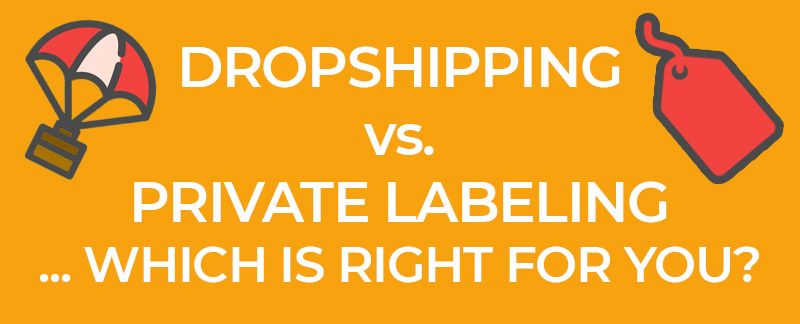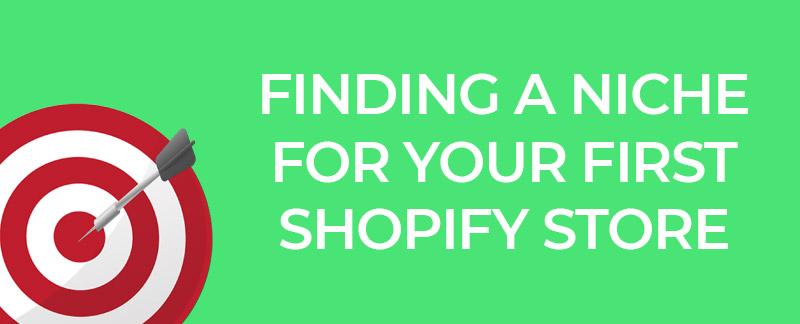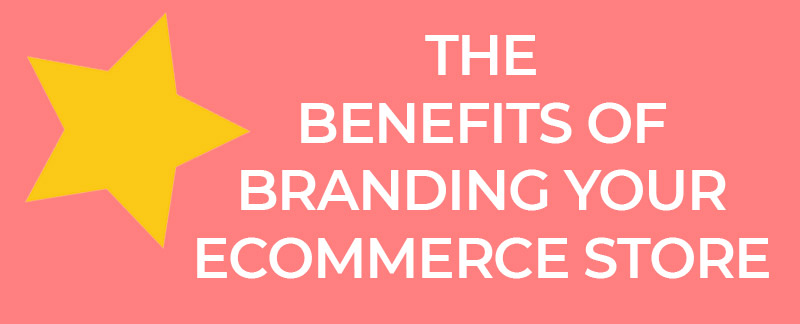Dropshipping vs. private label - this is a comparison that a lot of people make or want to know more about.
Which is better for your business? Well... I can't tell you exactly.
Both of these strategies have perks and drawbacks that can determine which works best for your scenario. So, it's best that you inform yourself to make your own decision.
That's where I come in, to give you my personal experience with both and to discuss what they both brought to the table for my ecommerce business.
What Are Dropshipping and Private Labeling?

Dropshipping
Dropshipping is the process of shipping directly to a customer from the supplier without ever touching the product.
There’s no branding, no custom packaging, just point A to point B products. Very low effort and hands off.
This is fantastic for people that absolutely have no extra time to spare but want to get their feet wet with eCommerce. That was me a few years ago.
Private Labeling
Private labeling is, in short, ordering products in bulk, branding the product and the packaging in some way, and then shipping that to the customer.
With this, you act as a more involved middleman and get some great perks that will be discussed later on in this article.
While it seems like a process that is far out of the average person's reach, it is, in reality, a lot more accessible and more rewarding than simple dropshipping.
Now, both of those strategies have their benefits and drawbacks, so I’m going to give you my exact process of going from dropshipping to private labeling while covering the pros and cons of both.
Then afterwards, I’m going to cover logistics and numbers, because some people want hard facts. Also, it’s just kind of fun for me.
Pros and Cons of Dropshipping

Initial Dropshipping Experiences
So, I started dropshipping two years ago. It was a rough start, I’ll tell you that now.
I lost money for a good couple of months before I started to really understand the business model, understand my niche, and understand my market.
After a lot of testing and money spent, I'm talking hundreds of dollars and weeks of testing, I eventually found a good sub-niche to hone in on, asa good product to sell.
I made a few sales of this product, started digging myself out of the money hole I had dug myself into, and worked on making things better.
All the while I was testing new products, new marketing strategies, and just really understanding the market I was in.
Now remember, this entire time I was dropshipping, meaning I never stocked the product myself.
This right here is one of the reasons I love dropshipping and the reason why I think it's a great option for someone to get introduced to eCommerce.
Perks of Dropshipping Stores
The fact that I didn’t have to worry about inventory meant I could test a TON of different products with no risk.
I could create an entire advertising campaign for a product, and if after a week or two I found it didn’t sell, I could just scrap it without having to worry about having hundreds of units of stock leftover.
Such a low-risk and low-commitment business model was absolutely pivotal to my success because of the fact that it took me months to find something that worked.
Stocking my product would have cost so much time and money when I had zero income.
This is how I actually went about fulfilling my first 200 or so orders - entirely dropshipping. This is how I would recommend everyone starts off.
However, there were some major drawbacks to this.
Drawbacks of Dropshipping Stores
First of all, since products ship from primarily China, shipping times are slow. Painfully slow. A decent amount of customers weren’t even getting their orders.
The slow shipping time isn’t a huge problem as long as they got their products, but it really didn’t make my customers want to come back and buy from me again.
Next, the packaging was terrible. A customer’s disappointment when they wait 3 weeks for a package and it comes in a tiny yellow chinese envelope is immeasurable.
Fine at the beginning of things, but when you’re trying to grow a solid brand with returning customers, this isn’t going to do it. It doesn’t give a premium experience, and makes your product look bad.
Quality control is also non-existent. I realized this was a problem when I’d get a substantial amount of customers contacting me that their product was messed up in a way.
Now, the products were cheap, so I just sent them another one for free, but this was still a huge headache that costed me money and the trust of my customers.
Finally, and this is a big one, profits weren’t that great. When I get into fine details later on in this article, I’ll show you how important this is.
It was clear to me, though, that I was losing out on a lot of profits by ordering one-offs on AliExpress.
It was at this point that I needed to analyze the situation I was in.
I had two main products that were selling well for me. They had been selling consistently for weeks, and they didn’t show signs of slowing down any time soon.
Pros and Cons of Private Labeling

Transitioning Into Private Labeling
After considering the problems I discussed in the previous section, I decided to private label these winning products.
Notice how I said these products, and not every product.
I did have other products on my website that sold passively, but I didn’t sell enough of them consistently to warrant me buying them in bulk, so I continued to dropship those.
This mixture of self-fulfillment of your best selling products and dropshipping additional products is the strategy that I’ve used in all of my dropshipping ventures.
It makes sense when you weigh the costs and benefits.
So, once I decided to private label, I headed to Alibaba.
I ordered my products in bulk, around 200 units each for my first order, and got them for extremely cheap. Once again, I’m covering specifics a bit later in this article.
I then went on Amazon and ordered some small bubble mailers because my products were of the jewelry type, and I additionally ordered some small velvet bags.
Finally, I went on Vistaprint and ordered 500 business cards for around $10 that thanked the customer for their order and gave them a discount code for future purchases.
Once I got all of those elements in, I simply started self-fulfilling my products, and the benefits were pretty immediate.
Benefits of Private Labeling Products
- I was able to get my products to my customers in 3 days, which is almost unheard of for my niche since everyone in it simply dropships.
- Customers got their order in a clean bubble mailer with their product in a nice velvet bag and a thank you card with a discount code that many of them redeemed. Nobody did this, and I got a ton of repeat customers.
- No customers got broken products anymore. I was able to inspect each product before it went out, dropping my return rate to almost 0.
- My profits shot up. I think that factor made me the happiest.
Now yes, there are some downsides that I’ll point out now.
Drawbacks of Private Labeling Products
There’s a little bit of risk because it’s not guaranteed that you’ll get through your inventory before your product dies out.
This can be lessened by simply controlling your order amounts and not jumping into bulk ordering until you’re sure you have a consistent winner.
Next are shipping concerns, and yes, this is a big one that may not make this possible for people.
When you’re self-fulfilling, you’re shipping the products yourself. This means that it may not be possible to ship internationally.
For me, most of my customers were within the US, which is where I live, so this was a no-brainer for me, and I’ll cover shipping logistics in a little bit.
Any orders outside of the US I simply dropshipped, which were few and far between.
Probably the biggest concern about this strategy, though, is related to time.
I’ve gotten tons of comments telling me that they got into dropshipping because it’s very low effort and doesn’t take a lot of time, so they don’t like the method of private labeling.
That peeved me in two ways.
First, that’s a terrible approach to business. Put 100% into your ventures if you want to be successful or don’t do it at all. You won’t see the success you want if you half-ass it.
I understand you may have another career taking up time, but with proper time management, this is doable.
You can also outsource to a domestic warehouse, but I advise against it until you’re doing very large numbers.
Secondly, the time put in to this change of business was rewarded handsomely through profit increase due to buying in bulk. Well above minimum wage for the amount of time put in.
Let’s now go over logistics so you can see for yourself.
Clear Benefits of Private Labeling

Logistics of My Dropshipping Experience
I’m going to look at things during the time frame of my transition from dropshipping to private labeling. During this time, I was getting between 15 and 20 orders a day.
The main product I was dropshipping at this time cost me $6.50 to ship from China to my customer, and I was charging $20 on my website.
This is a $13.50 profit margin per product. Not bad.
Side note, I know there’s fees from Shopify and other things. I’m just negating it since it’s about the same difference for both scenarios.
Now, these shipments were not very good. They arrived in, on average, 2.5 weeks. The package was very small, and the product itself was not presented well at all.
Additionally, a good amount of products were getting lost or broken. I’d say at least 5% of my products, or one product per day was damaged or lost.
On a day when I was making 15 orders, this was $202 profit. Minus the cost of a replacement product, I’m at about $196. This isn’t terrible, but could be improved.
Also remember, during this time, because of the fact that my buying experience was so poor, I wasn’t getting repeat customers.
I fell into the trap of getting one-time customers, which is what a lot of so-called dropshipping gurus like to tell you. This is terrible.
We want to keep our customers around because the cost of customer acquisition is so high. We need them to buy from us more than once, and they won’t do that when their buying experience is poor.
So, with dropshipping, I’m making $196 profit a day, only getting one-time customers, but saving some time out of my day. Not bad, but can be improved easily.
Let’s look at the same situation while private labeling and self fulfilling.
Logistics of My Private Labeling Experience
I was able to buy a bulk order of 200 of my product for, get this, $1.50 per unit. That brings me to a $18.50 profit point per product.
But Zach, what about all that extra stuff you bought?! And shipping?! I didn’t forget. Let’s calculate that.
I can get a pack of 50 bubble mailers for $7. That’s $.14 per bubble mailer.
I can get a pack of 80 velvet bags for $17. That’s $.21 per bag.
I can get a box of 500 business cards for $10. That’s $.02 per card.
I can then ship this envelope anywhere within the US for $1. I’m not kidding. Because this is under an ounce, this is my shipment price.
It costs more for larger products, so do your research on shipping prices for your product before jumping into this.
Taking that all into account, we now have our original profit margin of $18.50 minus $1.37. After all of that, I’m still at a whopping profit of $17.13 per unit sold.
That’s $3.63 extra PER UNIT SOLD.
When I’m selling 15 units a day, that’s $54.45 in extra revenue I was missing out on!
Not to mention the fact that I’m now getting repeat customers buying from me 2, 3, or even 4 times because my service is so fast and high quality.
This ties back into the time dilemma we had earlier. Per day, I would spend an hour at the most fulfilling these orders.
That means for one hour of work, I’m making $54.45/hr. That’s the salary of a computer scientist and pharmacist. Even at half this rate, tell me it isn’t worth your time again.
Final Words
So yes, while this article was long and full of details, I am still simplifying things.
Everybody’s situation is different, and you need to use the information in this video to best judge your situation and determine the best course of action.
However, after presenting my story and the numbers behind things, I hope your mind is a little more open to the possibilities of eCommerce.
Private labeling and self-fulfilling, once you’re at the point to do so, has a lot of benefits that will really take your business to the next level when combined with other things such as strong back-end marketing.
In short, dropship until you’re confident in a product, then private label that product and scale up from there. Or at least consider it.
That’s what I did, that’s what my own father is doing, and it has the potential to really work for you, too.




Excellent article! Not only private labeling offers more customization… but also you deliver much faster shipping times to your customers in comparison to dropshipping.
Totally agreed, Brennan! If you CAN private label your products, you SHOULD, 100% 🙂
You are totally right, people like doing things in a faster way but in the long run private labeling will be better of. Hoping to join your group sooner. Thanks for the information, more power to your elbow.
This is a very nice article and could not agree more with you…Now I have a question: what about doing private label when living outside the country you sell? Is there any company who offers that service in the US?
Absolutely! There are warehouses in nearly every substantial country that you could be selling in. It would just require a bit of Googling to find those warehouses/distributors.
I’m really excited about private labelling. Thanks a lot for well explaining this topic.
You’re welcome Sohaib! Glad I could help you out!
Hi Zach,
What do you think about dropshipping through WordPress?
I’m a fan! In fact, it’s a huge part of my ecommerce website that I’m running right now 🙂
Hi Zach, and thank you for this informative article.
Would you say it’s a good idea to have 2 separate websites; one to test products through dropshipping, and the other to slowly add more of the winning products from the dropshipping site?
Thank you again for your time and effort.
Best Regards,
Ray
I have the same question as Ray!!
Do you offer any courses on private labeling?
[…] On Tuesday, Michigan Attorney General Dana Nessel (D) issued a seemingly innocuous warning about holiday-themed scams. Of course she got blowback from Trumpist/QAnon dead-enders who still refuse to admit that outgoing President Donald Trump lost the election, but Nessel also got some blowback from people who did not like what she had to say about dropshipping. […]